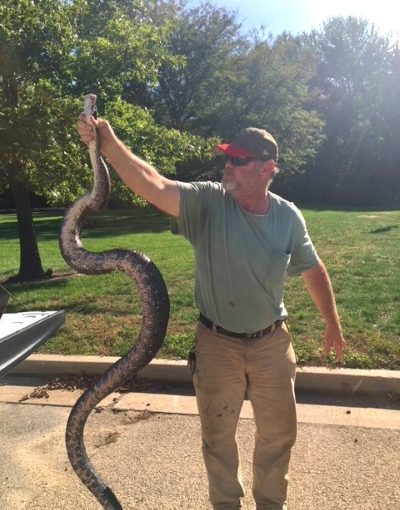 Imagine that you are sitting along the Mississippi River shoreline in Fulton, IL, with fishing pole in hand, drowning a few worms, and enjoying a sunny day. Suddenly, you see something move out of the corner of your eye. That “something” turns out to be a seven-foot-long boa constrictor, that is lazily sunning itself on the rocks next to you and probably wondering if you are ever going to catch a fish.
Imagine that you are sitting along the Mississippi River shoreline in Fulton, IL, with fishing pole in hand, drowning a few worms, and enjoying a sunny day. Suddenly, you see something move out of the corner of your eye. That “something” turns out to be a seven-foot-long boa constrictor, that is lazily sunning itself on the rocks next to you and probably wondering if you are ever going to catch a fish.
Logan Foster of Fulton was traveling along the road to his favorite fishing hole at Lock and Dam 13, on Monday, July 23, 2018, when he observed a large snake lying along the road. Foster took a picture of the snake; it was identified as a boa constrictor.
Many native species of snakes are present in our Mississippi River area, but boa constrictors are not one of them.
In late September, the U. S. Fish and Wildlife Service became aware of rumors that a boa was present in the Potter’s Marsh area of the Upper Mississippi River National Wildlife and Fish Refuge. Refuge staff advised the Corps of Engineers staff at Lock and Dam 13 to be on the lookout for the boa.
Mark Nettles, left, a Corps of Engineers employee, was on his way to work on the morning of Wednesday, October 3, when he spotted the boa, lying alongside the road near Lock and Dam 13. He is a snake buff and happily rescued the-seven-foot-long snake, which could barely move due to the cold temperatures. Nettles loaded the large boa into the bed of his truck and notified the refuge.
Several calls were made by the refuge to find someone who would accept this large boa constrictor. Don Decker, a snake savior and educator from Cedar Rapids, IA, gratefully adopted the docile boa. He took it home to join the rest of Decker’s snake family.
Refuge staff encourages snake lovers who no longer want their pets, to reach out and find someone to adopt the pet, rather than releasing it into the wild. Many people are terrified of snakes. Coming upon a large boa may cause them to hurt themselves by tripping or falling, trying to escape from what they perceive as a dangerous situation.
There are many types of exotic pets being commercially sold that are not native to our area. Some of them end up being released into the wild, perhaps as in this case. Boas and other mild temperate animals will not survive our harsh winters and would die a slow, painful death. Refuge staff encourages the public to report unusual sightings of wildlife (especially exotic wildlife), for the health of the pet, humans, and the environment.
The Upper Mississippi River National Wildlife and Fish Refuge is the most visited refuge in the United States. The refuge extends 261 miles along the Upper Mississippi River from Wabasha, MN, to Princeton, IA, protecting and preserving habitat for migratory birds, fish, and a variety of other wildlife.
